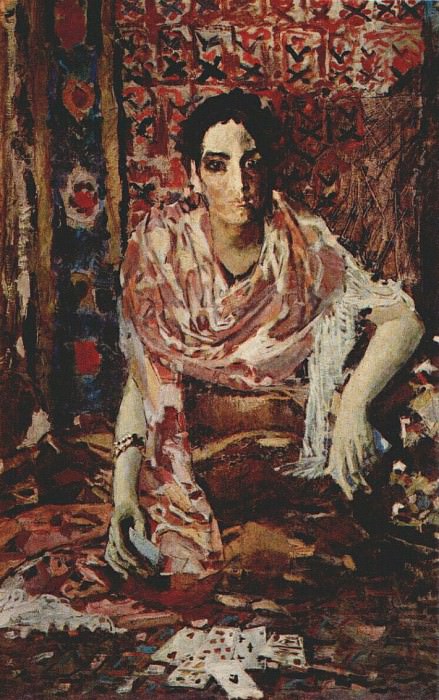vrubel fortune-teller 1895 Mikhail Vrubel (1856-1910)
Mikhail Vrubel – vrubel fortune-teller 1895
Edit attribution
Download full size: 710×1134 px (0,2 Mb)
Painter: Mikhail Vrubel
Vrubel loved to travel through countries. He visited: Rome, Milan, Athens and other cities, but his heart remained forever in the Russian capital, Moscow. Such wanderings had a positive effect on the artist’s works, leaving a fiery mark on history. The painting "Fortune Teller" is one such creative impulse. After visiting Spain, Vrubel began to write passionate canvases full of feelings and tenderness.
Description of Mikhail Vrubel’s painting "Fortune Teller"
Vrubel loved to travel through countries. He visited: Rome, Milan, Athens and other cities, but his heart remained forever in the Russian capital, Moscow. Such wanderings had a positive effect on the artist’s works, leaving a fiery mark on history.
The painting "Fortune Teller" is one such creative impulse. After visiting Spain, Vrubel began to write passionate canvases full of feelings and tenderness. Many critics and historians believe that after seeing the opera "Carmen" the artist in an outburst of feelings created this picture.
In literature, "Carmen" is a love story about a gypsy woman and her lover. This is where the plot of the painting comes from. At the center of the composition is Romelais, with an unusually wild and predatory appearance that conceals many secrets. The short hair reveals an authoritative and strong nature that can stand up for itself. Her short hair tells of a strong will to stand up for herself, and so does her body language. Her deliberate soft torso is contrasted with her confident hands. Her volatility is reflected in her disharmonious appearance and surroundings. The rich carpets do not match the simple clothing of the girl, who inspires thoughts of how she got here and where it all comes from?
The Roma people have always been attributed magical powers. Therefore, Vrubel put cards in the hands of the girl, which represent the connection with the nomadic people. To enhance the effect, the fortune-teller holds a mysterious ace of spades, foreshadowing a stroke of fate or a long journey full of danger and hardship. As if in mockery, the woman does not look at the cards, testing the strength of the one who comes to her.
Symbolism of color can also be found here. For example, the pink scarf, which traditionally signifies infantilism, here acquires a different character: the cunning and guile of the mysterious and unpredictable stranger. She possesses a look like a harem beauty who wishes to master the mastery of witchcraft.
Кому понравилось
Пожалуйста, подождите
На эту операцию может потребоваться несколько секунд.
Информация появится в новом окне,
если открытие новых окон не запрещено в настройках вашего браузера.
You need to login
Для работы с коллекциями – пожалуйста, войдите в аккаунт (open in new window).




















You cannot comment Why?
Perhaps it’s a painting of a man sitting on the ground in front of.